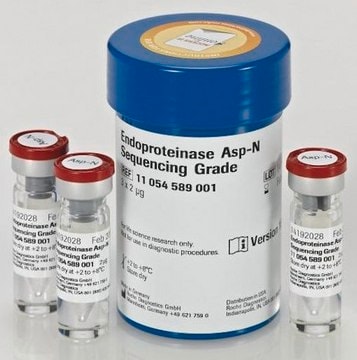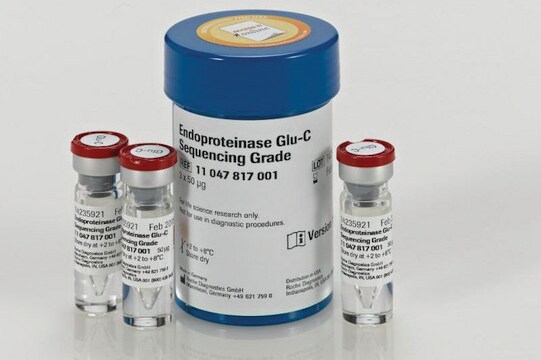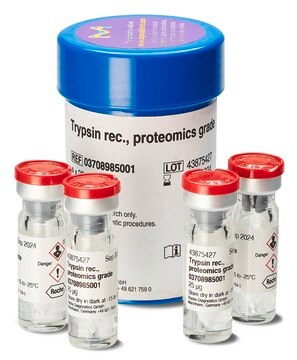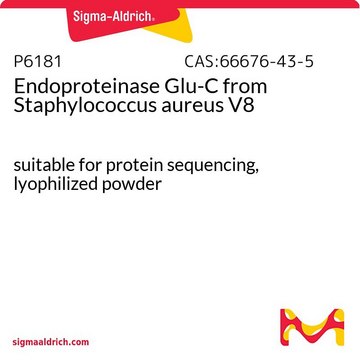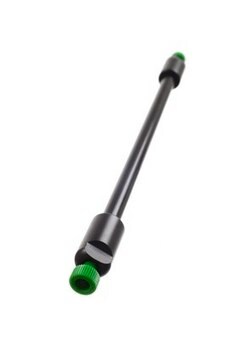ENDOLYSS-RO
Roche
Endoproteinase Lys-C Sequencing Grade
from Lysobacter enzymogenes
Synonym(s):
lys-c, lysyl endopeptidase, protease
Sign Into View Organizational & Contract Pricing
Select a Size
All Photos(1)
Select a Size
Change View
About This Item
Recommended Products
biological source
bacterial (Lysobacter enzymogenes)
grade
protein sequencing grade
form
lyophilized
specific activity
≥200 units/mg protein (at 25 °C, with Chromozym PL)
mol wt
33 kDa by SDS-PAGE (reducing)
purified by
electrophoresis
packaging
pkg of 3 × 5 μg (11047825001)
pkg of 5 μg (11420429001)
manufacturer/tradename
Roche
storage condition
(Keep container tightly closed in a dry and well-ventilated place.)
technique(s)
activity assay: suitable
Related Categories
General description
Endoproteinase Lys-C Sequencing Grade is isolated from Lysobacter enzymogenes as a highly purified and specific protease. Endoproteinase Lys-C from Lysobacter enzymogenes is a member of the peptidase S1 family. It is mostly used for the initial fragmentation of polypeptide chains in protein sequence analysis.
Specificity
This enzyme is a serine protease that specifically hydrolyzes amide, ester, and peptide bonds at the carboxylic side of Lys (in Tris-HCl buffer, pH 7.0 to 9.0).
Heat inactivation: Enzyme can be denatured using heat (5 min at 100 °C) or by TCA.
Heat inactivation: Enzyme can be denatured using heat (5 min at 100 °C) or by TCA.
Application
Use Endoproteinase Lys-C Sequencing Grade for protein structure analysis and for sequence analysis. It is suitable to digest proteins in solution, in polyacrylamide gels or on blotting membranes.
Preparation Note
Storage conditions (working solution): +2 to +8 °C
Reconstitution
Lyophilized Endoproteinase Lys-C sequencing grade is reconstituted in 50 μl double-dist. water. This results in a buffer concentration of 50 mM Hepes, pH 8.0, 10 mM EDTA and 5 mg/ml raffinose. To avoid autolysis, the incubation temperature should not exceed 37 °C.
Stable in 4 M urea.
Stable in 4 M urea.
Other Notes
For life science research only. Not for use in diagnostic procedures.
Storage Class Code
11 - Combustible Solids
WGK
WGK 2
Flash Point(F)
does not flash
Flash Point(C)
does not flash
Choose from one of the most recent versions:
Already Own This Product?
Find documentation for the products that you have recently purchased in the Document Library.
H Alexander Ebhardt et al.
Rapid communications in mass spectrometry : RCM, 28(24), 2735-2743 (2014-11-08)
Tandem mass (MS/MS) spectra generated by collision-induced dissociation (CID) typically lack redundant peptide sequence information in the form of e.g. b- and y-ion series due to frequent use of sequence-specific endopeptidases cleaving C- or N-terminal to Arg or Lys residues.
Tao Xu et al.
Nature protocols, 4(3), 325-332 (2009-02-21)
This protocol outlines the essential steps of mass spectrometry-based analysis of protein samples that can be used to identify post-translational arginylation. We describe special considerations for sample preparation and digestion, mass spectrometry analysis using high-precision instruments, database searching for the
Jung Hun Oh et al.
Journal of proteome research, 10(3), 1406-1415 (2011-01-14)
Many efforts have been made to discover novel bio-markers for early disease detection in oncology. However, the lack of efficient computational strategies impedes the discovery of disease-specific biomarkers for better understanding and management of treatment outcomes. In this study, we
Jason A Wall et al.
American journal of physiology. Heart and circulatory physiology, 291(5), H2462-H2472 (2006-06-13)
Ischemia-reperfusion (I/R) has critical consequences in the heart. Recent studies on the functions of I/R-activated kinases, such as p38 mitogen-activated protein kinase (MAPK), showed that I/R injury is reduced in the hearts of transgenic mice that overexpress the p38 MAPK
Our team of scientists has experience in all areas of research including Life Science, Material Science, Chemical Synthesis, Chromatography, Analytical and many others.
Contact Technical Service